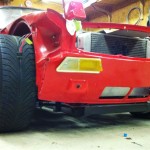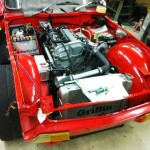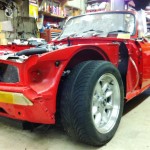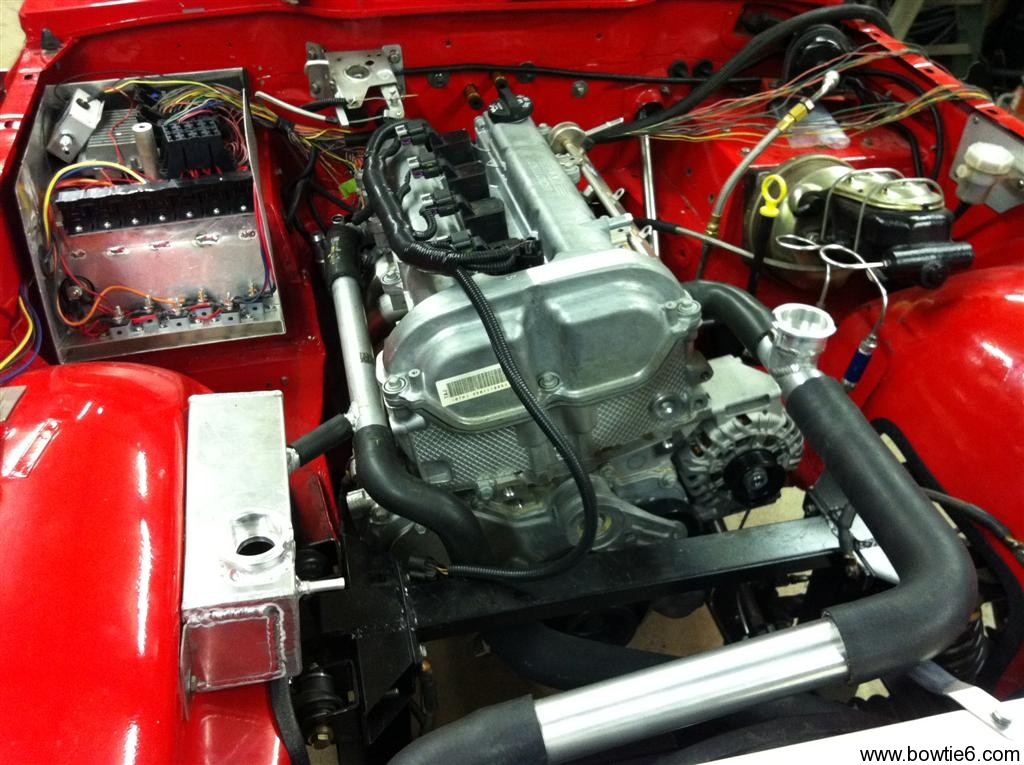Hi folks. Sitting here tonight, with a about 2 finger’s worth of Maker’s Mark 46 in a jelly glass. If you haven’t tried this, I highly recommend it. At any rate, here are a few recent pics of bowtie6 finally coming together.
Today is special actually. We put the wheels back on and dropped the car on the ground after doing the initial body tub fitment. Since the car has been on jackstands for so long, I had forgotten how damn low to the ground this thing really is. Take a look and you will see what I mean.
I’m sure you are wondering what type wheels/tyres are fitted. Answer:
- Wheels – Panasport sixteen by seven inchers. These are the Triumph bolt pattern and yes, they are Panasport. Not cheap, but these are the real deal.
- Tyres – The rears are 215/55-16; the fronts are 205/55-16’s. 215’s are a bit too wide for the front.
I know the pictures of the engine might be a bit overkill. After all, there are plenty plastered on my website. However, these are different…
- Check out the hand made aluminium intake. The plenum has been made to fit a GM Performance Parts intake flange. The flange has been made by the good folks at GM and it fits perfectly the intake runners on the head. Of course, all you get is a high pressure water-cut flange, the rest is all magic my cousin Jim made. You can see the electronic throttle body as well as the intake tube where the MAF and IAT sensors mount while on the bottom of the intake plenum is the MAP sensor.
- The headers are also hand-made and also attached to a GMPP exhaust flange. The flange actually is special because the size of the openings is much larger than the one on the stock exhaust. You get the idea.
- The Griffin aluminium radiator is fully bolted in and plumbed. Ecotec’s are special regarding plumbing. If you don’t get this dead nuts, the engine will overheat.
- The fuse box holds the ECM, fuses, relays, and electric fan controller. Yes it is a little crowded in there but there will be a cover for all this and when we get that bolted on, it will really look nice.
- Yes, those are Euro spec front turn signal lenses.
- Finally, the rear picture of bowtie6 shows the back fenders bolted back on. At the bottom you can see the exhaust peeking through. Those ends are not finished yet: that is where the Supertrapp baffles are bolted on. I am a big fan of Supertrapp mufflers and they not only give an awesome sound but are also very low restriction. I’ll have a writeup on this later, when I get all that bolted on.
I’m sure the question will be brought up: that engine is really pushed back towards the firewall. Why push it back so far back? Well the answer is simple: weight distribution. We don’t have numbers yet, but I’m hoping to have a near 50-50 distribution. My cousin’s TR4 is actually fairly close to this – don’t believe me? Then you need to check out my writeup on weight distribution.
So here are the pictures in no particular order:














